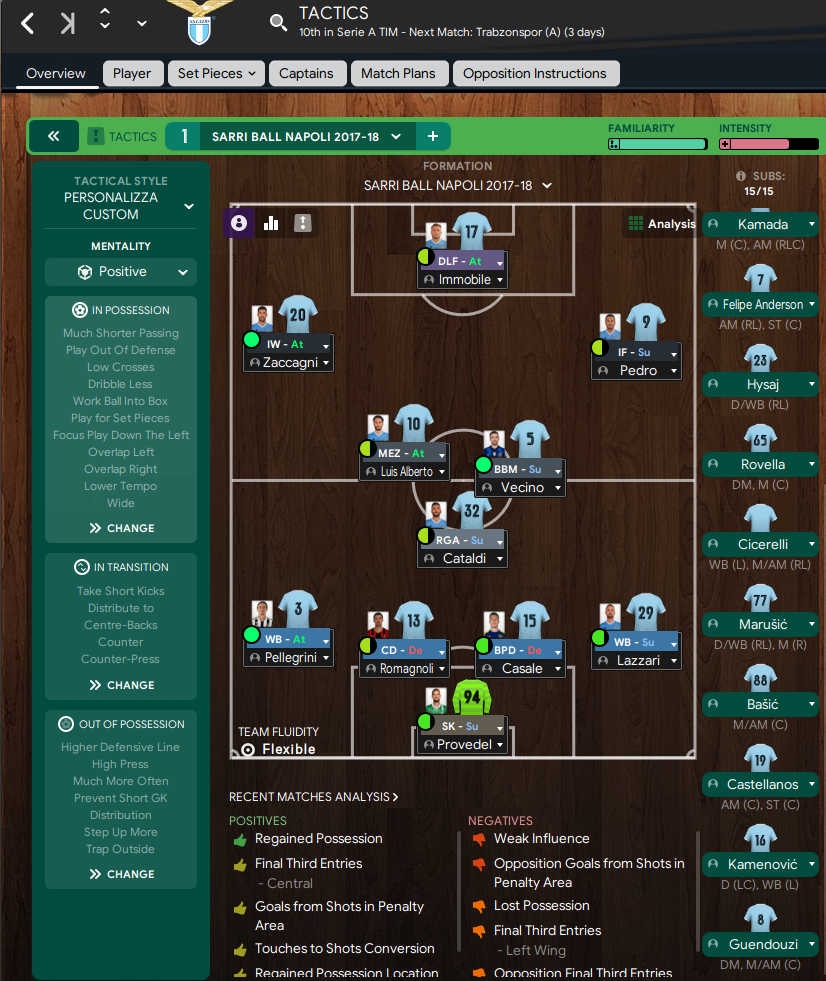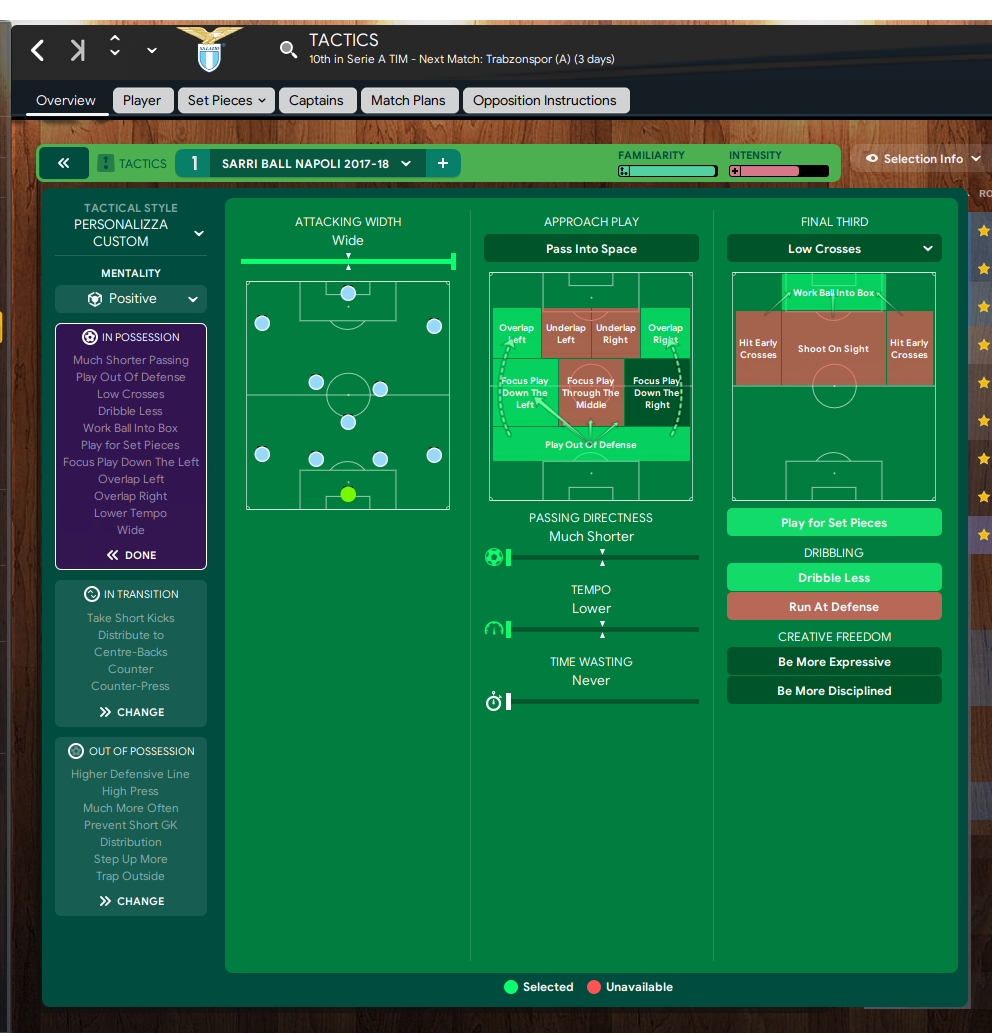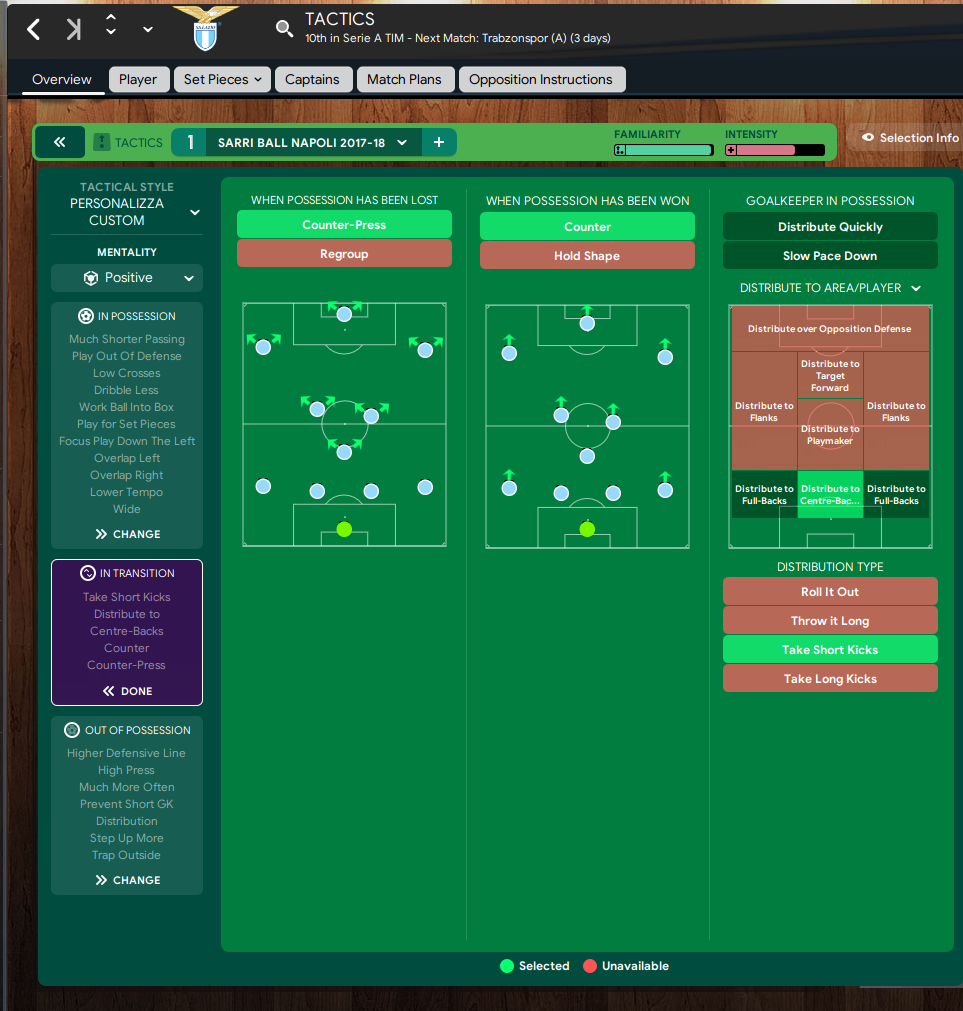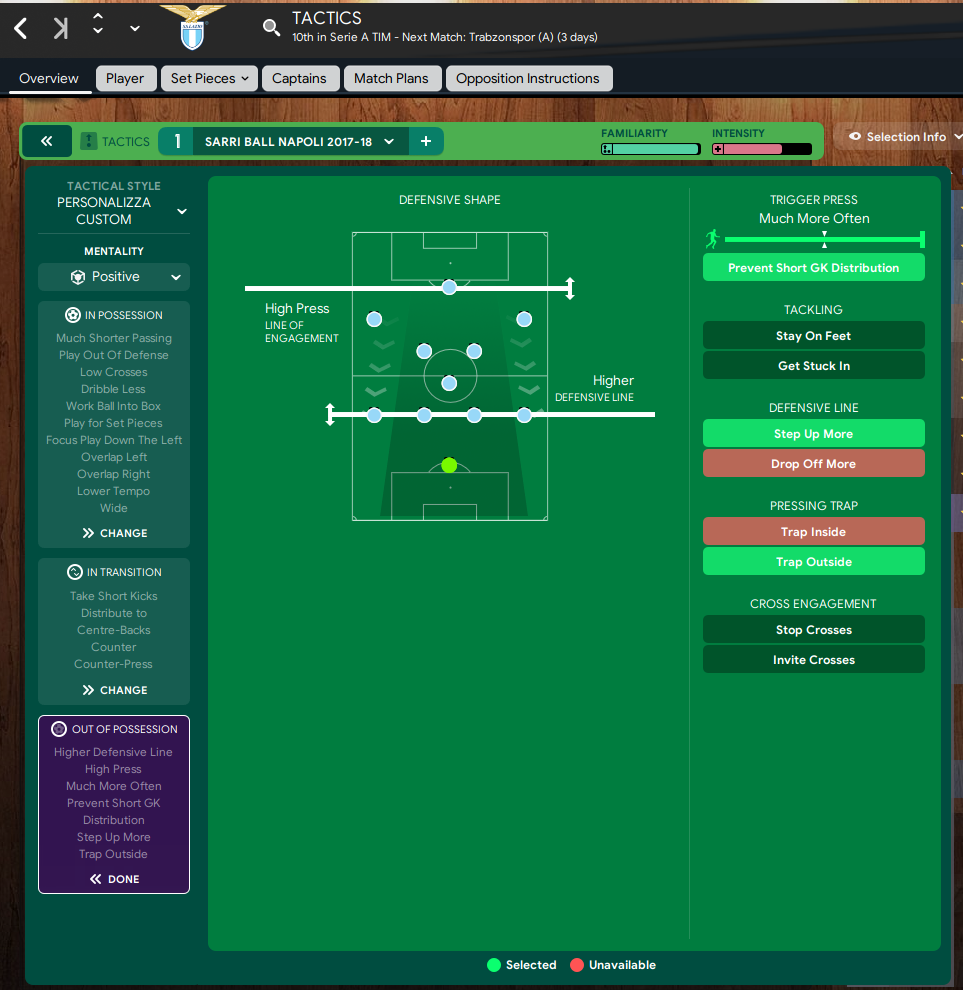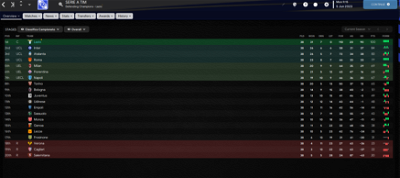| Tester | Team | ME | Win % | PPG | AGF | AGA | GD | PL | W | D | L | |
|---|---|---|---|---|---|---|---|---|---|---|---|---|
| Deleted User #1866315 |
 Lazio
Lazio
|
23.5.0 | 82% | 2.63 | 2.9 | 0.5 | 2.37 | 38 | 31 | 7 | 0 |
MAURIZIO SARRI’S NAPOLI 2017-2018 TACTIC: SARRIBALL
Maurizio Sarri's Napoli plays with a 1-4-3-3 formation that emphasizes speed, rhythm, ball control, and dynamism. The team prefers to keep possession of the ball in the opponent's half to control the game, and it's particularly effective in positive transitions. However, the team also places a strong emphasis on its defensive organization.
If there's a "flaw" in this squad, it's the lack of physicality in the attacking trident. On the other hand, the team compensates with great speed in short distances, which, combined with the quality of the players, makes Sarri's team aesthetically close to being "almost perfect." The identity Sarri has given to Napoli is admired throughout Europe as the team plays both organized and entertaining football, a rarity in Italian football.
In their static system, Reina stands between the posts. Although not coming off a great season, he is known for his personality and leadership. The defensive line consists of Hysaj as the right full-back and Ghoulam as the left full-back. Both frequently join the attack, usually aiming to cross from the byline, but they rarely enter the opponent's penalty area. In terms of defensive organization and one-on-one defending, they are solid but have room for improvement. The central defensive duo is composed of Koulibaly on the left center and Albiol on the right center. Koulibaly is physically imposing, excelling in reading the game and constructing play. Albiol is excellent in the air and technically adept, serving as the leader of the defense.
Napoli's midfield trio complements each other. Allan, the right central midfielder, is known for his work rate, effective linkup with Hysaj, and qualities in direct duels and positioning. Jorginho, in the central midfield role, is tactically astute, which compensates for his lack of physicality. He shines when orchestrating play due to his outstanding technical abilities. Hamsik, the left central midfielder, is an all-around player, performing well in all aspects and taking charge of the team during difficult moments.
The attacking trident consists of Callejon on the right, known for his tactical intelligence and willingness to work hard in defense. His best quality in attack is making runs to the back post. Insigne, on the left, is the most technically gifted player on the team. He times his runs well and is formidable when cutting inside to shoot with his right foot. Over the years with Sarri, he has become a well-rounded player and one of the best in Italian football. The central striker, Mertens, excels at making runs both short and deep, is skilled in one-on-one situations, lightning-fast, and rarely misses in front of goal.
In possession, the tactical system can be represented as a 1-3-4 formation, with all ten outfield players actively participating in the build-up. The back three consists of the two central defenders, Koulibaly and Albiol, with Koulibaly excelling in the preventive game. They are accompanied by one of the two wide defenders (in the image, Hysaj).
The three midfielders, Hamsik, Jorginho, and Allan, also maintain their positions in the static system. In possession, these three players move a lot, offering continuous solutions and often positioning themselves staggered to provide passing options.
In the offensive phase, one wide defender participates in the build-up to stretch the play on one side. An attacking winger provides width on the opposite side, and finally, the central striker and the ball-side attacking winger position themselves centrally.
In the defensive phase, the team organizes itself in a 1-4-1-4/1 formation when forced into their own half, with only Mertens not actively participating in the defensive phase. However, when pressing the opposing team during their build-up, the formation shifts to a 1-4-4-2, with all eleven players engaging defensively.
The back four consists of Hysaj on the right, with Koulibaly and Albiol in central positions, and Ghoulam on the left. Jorginho takes responsibility for the defensive zone in front of the backline. The line of four midfielders includes the two wide attacking players, Callejon on the right and Insigne on the left, as well as Hamsik (who is also responsible for the offensive pressing, as you will describe later) and Allan.
The only player who stays in a more advanced position, trying to anticipate and break the opponent's play, is the central striker, Mertens.
In the possession phase, Napoli builds from the back whenever they are not under intense opposing high-press pressure, which would force them to play long balls forward. When faced with pressure from a single opponent, the defensive line takes advantage of the 3 vs. 1 situation that develops. This situation involves Reina, Koulibaly, and Albiol against the opposing attacker. In this scenario, the two central defenders spread out towards the vertices of the penalty area, while the wide defenders move out to cover the width of the field, positioning themselves level with the central midfielders.
Reina plays the ball to the freer teammate. The recipient advances with the ball to attract the opposing pressure, creating space. During this phase, the central midfielders, particularly Hamsik and Jorginho, position themselves to receive and enhance the quality of the build-up. The two attacking wingers, Insigne and Callejon, adjust their positions inward, creating an open lane for Ghoulam on the left and Hysaj on the right.
When facing intense opposing pressure that doesn't allow for a ground build-up, Napoli doesn't take unnecessary risks. The long ball forward is not a preferred strategy because there isn't a fixed target player to receive it. However, this approach can be risky as it often results in the ball being won back by the opponents, partly due to the lack of physicality in Insigne, Mertens, and Callejon when it comes to offensive duels.
The development of the play predominantly occurs on the left side, where the combination of Ghoulam, Hamsik, and Insigne works perfectly.
Once the initial line of pressure is overcome, the central midfielder on the ball side and Jorginho position themselves to provide two passing options to the ball carrier (support or a pass in a supportive position, depending on the situation). Mertens constantly moves between the two central defenders to prevent them from pressuring the attacking winger on the ball side, who cuts inside the field to receive and combine with the supporting wide defender.
The attacking winger on the weak side stays wide to attack the penalty area, starting from behind their direct opponent. When the wide defender gains possession, all three forwards attack the penalty area.
Hamsik, Insigne, Mertens, and Callejon actively seek to receive the ball in the finishing zone. Jorginho, whenever possible, looks to serve them by playing the ball to their feet with their back to the goal. Callejon, who may not be as technically gifted as the other three attackers, often plays a quick pass to the nearest supporting player when he receives the ball. On the other hand, Mertens and Insigne exhibit more versatility in their play. They can turn and take on their direct opponent with a clear technical advantage, or they can opt to pass to a teammate making a run into space.
When Jorginho looks for Hamsik in the finishing zone, Insigne quickly attacks the depth. As soon as Hamsik gains possession, he consistently plays the ball vertically to his teammate, who often finds themselves in a one-on-one situation with their direct opponent. This allows them to cut inside on their stronger foot (usually the right foot for the Neapolitan attacker) for a curved shot on goal, which is one of their best qualities.
The finishing mainly comes through two methods. First, it involves crosses and deliveries from the wide areas, where Mertens consistently attacks the near post, the attacking winger on the ball side positions themselves in the center of the box, and the opposite-sided attacking winger moves to the far post.
Secondly, the team also looks for through balls for the three forwards, who are skilled at making well-timed runs behind the defensive line. In the typical scenario with the attacking wingers cutting inside, Insigne often delivers these through balls to his teammates. However, when the build-up is slower, and the opposing team manages to create density around the ball, the through ball is directed towards the wide attacking winger on the opposite side, who starts wide and, with a movement from outside to inside, attacks the penalty area.
NON-POSSESSION PHASE
In the defensive phase, Sarri's Napoli employs an ultra-offensive press during defensive transitions and when the opposing goalkeeper takes goal kicks. In regular play, the 1-4-1-4-1 formation often transforms into a 1-4-4-2, indicating an offensive press strategy.
In the match you mentioned, when Nice was building up with only their two central defenders, Sarri adjusted by having Hamsik mark one of the central defenders, Mertens handled the other, and Jorginho moved up to join the line of four midfielders. Jorginho further pushed up his position when the opposing central midfielder dropped between the central defenders to effectively create a three-player build-up line. This compacted the formation back into the 1-4-1-4-1 setup.
One of the great qualities of this team is its ability to remain compact and close. The defensive elasticity works perfectly, and even in the previously described situations, Napoli's last line always closely follows the pressing of the offensive teammates. The primary reference in the defensive phase is the ball's position. The defensive line shifts horizontally based on the corridor where the ball is and vertically depending on whether the ball is covered or uncovered. When the ball is covered (even with a one-meter backward pass), the defensive line moves up, and as soon as the ball is uncovered, all players move together to eliminate the depth for the opponents.
The player tasked with "breaking" the defensive line is Koulibaly, and he does so very effectively, showcasing excellent skills in anticipation, direct frontal challenges, and even direct back challenges. He tracks the short run of the attacker, but not before being sure that the opponent will be the recipient of the pass, so as not to unnecessarily break the defensive line. In situations where the ball is uncovered, the line retreats well up to the edge of the penalty area, after which Koulibaly advances with the ball to engage the direct opponent in a one-on-one duel.
The weak link in the defensive phase does not stem from collective mistakes but rather from the individual deficiency in one-on-one defending. Despite constant doubling by teammates (Callejon or Jorginho), which prevents the direct opponent from cutting inside, Hysaj is regularly beaten on the outside, thus allowing opponents to easily deliver crosses.
ATTACKING TRANSITIONS
In defensive high positions, Mr. Sarri's team manages to win many balls in the opposing half, often even near the penalty area. Consequently, the primary objective is inevitably to quickly go for the goal with individual actions or combination plays.
DEFENDING TRANSITION
As described earlier, Napoli often plays in the opposing finishing zone, creating the most danger from this area. However, it's also the zone where they lose the most balls, due to the limited space and high density of players. When this happens, Sarri's team finds itself with the defensive line near the midfield and at least 5-6 players around the ball. Therefore, immediate pressure on the ball carrier and closing off passing lanes happen almost automatically.
STRENGTHS
A starting lineup that has been solidified for the past two seasons.
Unpredictability provided by Mertens and Insigne.
Excellent organization in all phases of the game.
The ability to control and vary the pace at will.
WEAKNESSES
Hysaj's weakness in one-on-one situations during the defensive phase.
Limited bench options for the defensive line.
Lack of physicality up front (if Milik remains on the bench).
A lack of effectiveness in the goal-scoring zone.
HOW TO EMULATE SARRIBALL ON FOOTBALL MANAGER 2023
First, the mentality of this tactic is positive. As always, when you choose your team mentality on Football Manager, there are a few things you must consider. Every year the match engine slightly changes, so a mentality that worked well on previous editions of FM does not work well in FM 23. This is the case of the balanced mentality that worked really well on FM 22 but on FM 23 it allows too much space for the opponent who can dominate the game. So if you don’t want to use an offensive mentality because you are afraid to allow too many fast counters to the opponent, the only thing you can do is use a positive mentality.
Then you can adjust your playing style in the team instructions.
As we said , Sarri's attacking phase is great but he cares a lot about the defensive phase too, even if he lacked a great right wing-back, Hysaj, if left alone by his teammates, showed all his weakness in one-on-one situations. So I tried to minimize those situations in my tactic, since I picked Lazio, the team Sarri is managing now and where Hysaj is often playing as a wing-back (even if on the left).
Let’s now see the team instructions and then we will analyze each player's roles and instructions.
In the possession’s phase, the attacking width was wide, Sarri wanted his Napoli to exploit wider areas especially on the left side with Mario Rui and Insigne, stretching the opponent’s defense and creating spaces for other players, in particular Hamsik and Callejon to get inside the box.
Having that said, play out of the defense is another important instruction, Sarri wanted (and still wants) his players to build from the back, in that Napoli, Reina, Koulibaly and Albiol could build from the back when the opponent pressing was made by only 1 player (usually the striker) because they could play the ball being in a 3 vs 1 situation, but when the opponent started pressing with more players, Reina could prefer a long ball to the left wing-back Mario Rui who was already moving forward helped also by Insigne’s drop back movement.
As we said, Napoli focused his play on the left side more than on the right, so I also chose the instructions “focus play down the left” and “overlap left and right” because even if Hysaj was less attacking he still could help in the attacking phase.
About passing style and tempo, I chose lower tempo and much shorter passing to play more patiently and control possession (you could switch to slightly lower tempo and slightly shorter passing if you see your team is struggling to score, but in all the matches I played I always saw my players playing very beautiful passes, always finding a solution to avoid the opponent’s pressing). Crosses are low (that Napoli had Mertens as striker because Milik was often injured). Work the ball into the box, and, to control possession even more, play for set pieces and dribble less are the last two instructions of the possession phase.
In the transition phase, distribute to center backs and take short kicks are the two goalkeeper’s instructions. Sarri wanted his players to press high and counter attack, obviously I chose those instructions.
In the non possession phase, the defensive line is higher, (not much higher because it would be too dangerous against long balls), and so is the pressing line. The pressing is very intense so much more often is the right instruction, together with prevent short gk distribution. Other instructions are step up more to help the offside trap and trap outside.
That’s all for the team instructions.
Let’s now analyze each player’s role and positions.
Reina was a sweeper-keeper and this is how Sarri wants his keeper to play now too, Provedel is another example. I chose a sweeper-keeper on support with no instructions.
The right wing-back (Hysaj’s role on that Napoli, Lazzari’s role in Sarri’s Lazio) is a wing-back on support with the following instructions: close down more, mark tighter, cross from deep (both Mario Rui and Hysaj did not cross from the byline but tried crossing from a deeper position) and cross aim far post because this is an instruction which really works on FM 23).
On the opposite side, Mario Rui (now in Lazio Luca Pellegrini or Marusic, I used more Luca Pellegrini than Marusic) is a more offensive wing-back, a wing-back on attack with the following instructions: take more risks, mark tighter, cross more often, cross aim far post,stay wider, close down more.
Now let’s analyze the two central defenders of Napoli, one was Raul Albiol, the leader who also decided how the other defenders should move and Koulibaly, a very good marker, very fast so he could win one-on-one situations against fast strikers too. In Sarri’s Lazio we have Romagnoli and Casale, two good defenders, Romagnoli also very good with the ball.
Albiol’s role on FM 23 is more a central defender on defend (with the instructions to close down less, mark tighter and take fewer risks) while Koulibaly’s role is a ball playing defender on defend with mark tighter, close down more and dribble more (to replicate Koulibaly’s movements forward with the ball).
Now, the midfielders trio: Jorginho was the playmaker but not a deep-lying playmaker who only cares of acting as a shield in front of the defense, you could find him moving forward helping Napoli to build the attack, so I chose a regista role with the instructions to get further forward to emulate his forward movements and close down more to tell him to press the opponent. Cataldi plays in this role in Lazio.
Allan is a defensive midfielder, the more defensive of the trio, but he could also move forward and sometimes tried long shots. His role on FM 23 is a Box to Box midfielder and I instructed him to get further forward. Vecino plays in this role in Lazio and sometimes I let Guendouzi replace him, Vecino scored 4 goals and made 3 assists in 24 apps, while the French midfielder scored 1 goal in 21 apps.
Now, Marek Hamsik’s role (Luis Alberto in 2023-2024 Lazio after Milinkovic- Savic moved to Saudi Arabia in summer 2023), this is a perfect example of a mezzala on attack with the instruction to shoot more often. Luis Alberto played an incredible season being Serie A top assist man (21 assists in 35 apps) and scoring 11 goals.
Last but not least, the attacking trio, Insigne-Mertens-Callejon. Let’s start with Insigne. Lorenzo Insigne had a lot of space in Sarri’s tactic because it’s true that he often stayed wider to stretch the opposition’s defense and allow Hamski and other players to exploit the spaces in the central areas, but who does not remember his “tiro aggiro” curved shot? He often cut inside with the ball and shot beautiful goals with his incredible shots. In Lazio, Mattia Zaccagni plays as left winger. I chose an inverted winger on attack for this role with the instructions to cross aim far post to emulate those crosses from Insigne to Callejon who moved into the box from the right, hold up ball because Insigne loved to do so, roam from position (as said above, he had a lot of freedom and nearly no defensive tasks) and sit narrower to tell him to stay closer to the striker.
Callejon’s role was less offensive than Insigne, more conservative, so I chose an inside forward on support instead of attacking and instructed him to cross aim far post, sit narrower and hold up ball.
Mertens’s role can be replicated as a deep lying forward on attack with the instructions to dribble less and shoot less often because I want him to link the play too. Immobile was Serie A top striker and very good in linking the play, with 41 goals and 10 assists in 37 apps.
I did not buy any players in this season 2022-23 so the squad at the end of the season is the same that began the season ( I just sent useless players, Lombardi and Rossi away on loan).
With this tactic I won Serie A, Italian Super Cup and Italian Cup, doing an Italian treble. I scored 110 goals (Serie A top attack) and allowed 20 (Serie A best defense). In the Champions League I qualified 2nd to the first round in a group with Arsenal, Barcelona and Union Berlin, but I got knocked out by Real Madrid. That’s all for my tactic I hope it works for you too.
Test Results
 Lazio
Lazio
| ME | Win % | PPG | AGF | AGA | GD | PL | W | D | L | |
|---|---|---|---|---|---|---|---|---|---|---|
| 23.5.0 | 82% | 2.63 | 2.9 | 0.5 | 2.37 | 38 | 31 | 7 | 0 |
Won the Italian treble with Lazio (Serie A, Italian Cup and Italian Supercup) , got knocked out in Champions League 1st round of 16 by Real Madrid (2-2 home, 0-2 away) after finishing 2nd in the group stage in a group with Barcelona (1st), Arsenal (3rd) and Union Berlin (4th).
You'll need to Login to comment
